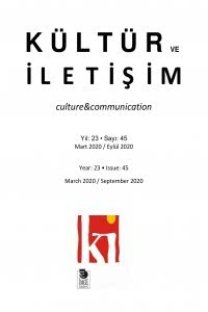Arendt'in Rahel Varnhagen'ı: Kamusal-Özel Dikotomisine Bir Meydan Okuyuş
Hannah Arendt’in ilk dönem eserlerinden biri olan Rahel Varnhagen, Arendt üzerine yapılan çalışmalarda genellikle Arendt’in geç dönem siyasi yazılarından farklı ve ayrıksı bir yere sahip olarak değerlendirilir. Fakat bu biyografik eser aynı zamanda Arendt’in çalışmalarının vazgeçilmez unsurlarından biri olarak gözüken kamusal-özel dikotomisine meydan okumaktadır. Bu makale, biyografide, yer yer parvenu (irtifaperver) yer yer iseparya olarak sınıflandırılan Rahel’in bu deneyiminin, Arendt’in siyaset kuramındaki kamusal veya özel kavramları için yeni bir okuma olanağı yarattığını iddia etmektedir. Bunun da ötesinde, Rahel hem metin olarak hem de birey olarak bahsi geçen ikiliği muğlak hale getirmektedir. Bu ayrıksı çalışmanın ortaya koyduğu muğlaklık, Arendt’in diğer çalışmalarında baskın olduğu iddia edilen kamusal-özel dikotomisini sorgulamamızı sağlamaktadır. Rahel’de siyasi olan, kamusal ve özel olanın keskin bir biçimde ayrıldığı bir bağlamda değil; toplumsal olan olarak adlandırılan ve Arendt’in kuramında kamusal ve özelin arasında kalmış bir alan olarak kavramsallaştırılan on sekizinci yüzyıl salon kültüründe ortaya çıkmaktadır. Arendt’in siyaset kuramında siyasi aktör ve onların eylemlerine zarar vermeyen bir toplumsal olana işaret etmek, bizi negatiften ziyade, olumlanan bir toplumsal kavramı ile baş başa bırakmaktadır. Böyle bir okuma, Arendt’in çalışmalarında toplumsal alana tekabül ettiği için siyasi alanın dışında kalan kavram ve olguların yine Arendt’in çizdiği kuramsal çerçeve içerisinde yeniden değerlendirilmesine yol açacaktır.
Arendt’s Rahel Varnhagen: Challenging The Public - Private Dichotomy
Rahel Varnhagen, among the earliest works of Hannah Arendt, is often treated as an isolated piece in relation to her later political writings. However, this factual biography challenges one of the most inalienable elements in Arendt’s political theory: the public- private dichotomy. I argue that Rahel can be read as an exploration of the public or the private, that Varnhagen herself can be classified as either a parvenu or a pariah. A closer reading reveals that Rahel, as text and as individual, blurs this binary distinction. This blurring, in one exceptional text, helps to undermine the strict conceptual binary between public and private that is assumed to run through all of Arendt’s work. In Rahel, the political is not observed within the confines of a strict separation between the public and the private, but in an intermediate space: the social sphere of the eighteenth century salon. Identifying a conception of the social within Arendt’s political theory that is not detrimental to political actors and their actions would provide us a new reading of the social that is affirmative rather than negative. Such a reading would pave the way for a more inclusive reading of the social in Arendt, through which several “social” issues that are excluded from the political sphere may be recognized and re-conceptualized as political.
___
- Arendt, Hannah (1966). The Origins of Totalitarianism. New York: Harcourt, Brace & World.
- Arendt, Hannah (1958). The Human Condition. Chicago: University of Chicago Press.
- Arendt, Hannah (1974). Rahel Varnhagen: The Life of a Jewish Woman. New York: Harcourt Brace Jovanovich.
- Arendt, Hannah (1960). “Society and Culture,” Daedalus. 89(2): 278-287.
- Arendt, Hannah (1990). On Revolution. London: Penguin Books.
- Arendt, Hannah (1978). “We Refugees.” In Ron. H. Feldman (ed.). Jewish Identity and Politics in the Modern Age: The Jew as Pariah. New York: Grove Press.
- Armenteros, Carolina (1998). “Hannah Arendt, Rahel Varnhagen and the Beginnings of Arendtian Political Philosophy”. The Journal of Jewish Thought and Philosophy, 8: 81-118.
- Benhabib, Seyla (1996). The Reluctant Modernism of Hannah Arendt. London: Sage Publications.
- Benhabib, Seyla (1995). “The Pariah and Her Shadow: Hannah Arendt’s Biography of Rahel Varnhagen”. Political Theory 23(1): 5-24.
- Cahnman, Werner J. (1974). “Pariahs, Strangers and Court-Jews: A Conceptual Clarification.” Sociological Analysis. 35(3): 155-166.
- Canovan, Margaret (1974). The Political Thought of Hannah Arendt. New York: Harcourt Brace Jovanovich.
- Feldman, Ron H. (1978). “Introduction.” In Ron. H. Feldman (ed.). Jewish Identity and Politics in the Modern Age: The Jew as Pariah. New York: Grove Press. 15-52.
- Honig, Bonnie (1995). “Toward an Agonistic Feminism: Hannah Arendt and the Politics of Identity.” In Bonnie Honig (ed.). Feminist Interpretations of Hannah Arendt. Pennsylvania: The Pennsylvania State University Press.
- McGowan, John (1997). “Must Politics Be Violent? Arendt’s Utopian Vision.” In Craig Calhoun and John MacGowan (eds.). Hannah Arendt and the Meaning of Politics. Minneapolis: University of Minnesota Press. 263-296.
- Moruzzi, Norma C. (2008). “From Parvenu to Pariah: Hannah Arendt’s Rahel Varnhagen.” In S. Fleischacker (ed.). Heidegger’s Jewish Followers: Essays on Hannah Arendt, Leo Strauss, Hans Jonas, and Emmanuel Levinas. Pennsylvania: Duquesne University Press. 28-42.
- Pitkin, Hanna Fenichel (1998). The Attack of the Blob: Hannah Arendt’s Concept of the Social. Chicago: The University of Chicago Press.
- Ring, Jennifer (1991). “The Pariah as Hero: Hannah Arendt’s Political Actor.” Political Theory. 19(3): 433-452.
- Villa, Dana R. (1996). Arendt and Heidegger: The Faith of the Political. Princeton: Princeton University Press.
- Weckel, Ulrike (2000). “A Lost Paradise of a Female Culture? Some Critical Questions Regarding the Scholarship on Late Eighteenth-and Early Nineteenth-century German Salons.” German History, 18(3): 310-336.
- Weissberg, Lilian (1992). “Turns of Emancipation: On Rahel Varnhagen’s Letters.” Cultural Critique 21.
- Weissberg, Liliane (1997). “Introduction,” in Rahel Varnhagen: The Life of a Jewess. Baltimore: Johns Hopkins University Press.
- Young-Bruehl, Elisabeth (1982). Hannah Arendt: For Love of the World. New Haven: Yale University Press.
- ISSN: 1301-7241
- Yayın Aralığı: Yılda 2 Sayı
- Başlangıç: 1998
- Yayıncı: İmge Kitabevi Yayınları
